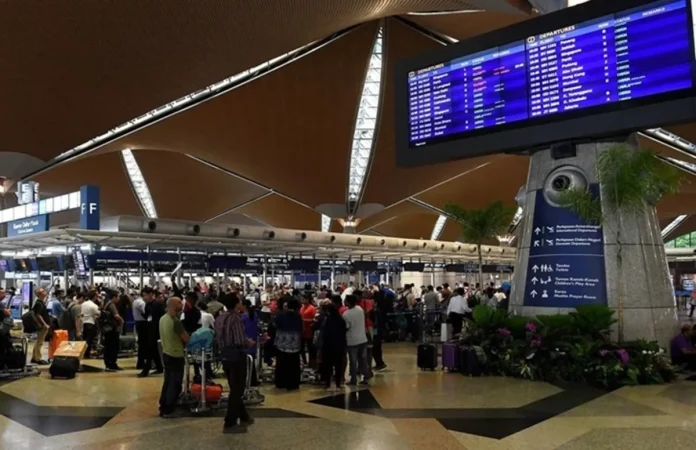PETALING JAYA: Malaysia continued to record a favourable current account balance in the third quarter of 2025, posting a surplus of RM12.2 billion, supported by resilient goods exports and an improving services sector.
The Department of Statistics Malaysia (DoSM) said the services sector posted a surplus for the first time in 14 years, marking a recovery since 2011.
The financial account registered a net outflow of RM11.2 billion, primarily from portfolio investment.
Chief Statistician Malaysia Datuk Seri Dr Mohd Uzir Mahidin said the goods account recorded a net export surplus of RM33.3 billion in the third quarter of 2025, almost doubling the RM17 billion recorded in the previous quarter.
Exports of goods expanded by 4.3% quarter-on-quarter to RM293.6 billion.
The increase was mainly driven by higher exports of electrical and electronic (E&E) products, petroleum products, and palm oil and palm oil-based products, primarily destined for Singapore, the United States and China.
Conversely, imports of goods fell by 1.6% to RM260.3 billion. The main category of imports comprised intermediate goods, followed by capital and consumption goods, primarily sourced from China, Taiwan and Singapore.
Notably, the services account registered a surplus of RM700 million in the third quarter of 2025, reversing the deficit of RM3.3 billion recorded in the previous quarter. This marks a significant milestone after 56 quarters since the last surplus in Q3 2011, buoyed by robust growth in the travel component.
Exports of services amounted to RM68.6 billion, while imports totalled RM67.9 billion.
Travel receipts surged by 11.8% from the previous quarter to RM29 billion, elevated by higher international visitor arrivals. At the same time, imports of travel rose 9.8% to RM15.9 billion, following greater outbound education-related spending.
As a result, the travel component recorded a higher net surplus of RM13.1 billion. Besides travel, construction and manufacturing services on physical inputs owned by others also contributed positively to the services account. Construction recorded a surplus of RM600 million on higher exports valued at RM2.6 billion, while imports declined to RM2 billion. Meanwhile, manufacturing services on physical inputs owned by others registered a surplus of RM4.1 billion, as exports of RM5.4 billion exceeded imports of RM1.3 billion.
“From the income standpoint, the primary income account posted a deficit of RM19.9 billion as against RM8.9 billion in the previous quarter. This reflected lower income generated from Malaysia’s investments abroad, which fell to RM19 billion, mainly from direct and portfolio investments. Simultaneously, income generated by foreign investors in Malaysia rose to RM38.9 billion, led by stronger returns in the same investment categories.
“On the other hand, the secondary income account recorded an improvement, with the deficit narrowing to RM1.8 billion from RM4.6 billion, mainly due to increased remittances and income inflows into the country,” said Mohd Uzir.
The financial account registered a net outflow of RM11.2 billion, compared to RM2.2 billion in the previous quarter.
“The higher outflow was mainly attributed to portfolio investment valued at RM28 billion, reflecting bond redemptions by non-residents upon maturity, coupled with increased investment in foreign securities by Malaysian investors. Financial derivatives recorded net outflows of RM800 million while net inflows were observed in other investment RM10.9 billion and direct investment RM6.8 billion,” he added.
Mohd Uzir said foreign direct investment (FDI) into Malaysia posted a net inflow, rising from RM1.6 billion to RM8.5 billion in the third quarter of 2025. The increase was primarily supported by larger equity injections. Most FDI inflows were channelled into the services sector, particularly within the information and communication and financial activities subsectors, notably linked to data centre activities.
The major investors of FDI were from Singapore, China and Japan. Meanwhile, direct investment abroad (DIA) registered a net outflow of RM1.7 billion from a net inflow of RM600 million in the preceding quarter. The inflows were driven by equity liquidations and reinvestment of earnings, mainly in the services sector, with the majority concentrated in wholesale and retail trade subsector.
Singapore, Thailand and Angola were the main contributors to DIA inflows during the quarter. As at the end of third quarter 2025, Malaysia’s international investment position posted higher net assets of RM77.3 billion. The total financial assets position reached RM2.59 trillion, surpassing total liabilities of RM2.51 trillion.
The cumulative investments for FDI and DIA were RM1,021.5 billion and RM615.8 billion, respectively. Asia remained the top region for both investments, with FDI largely from Singapore and Hong Kong while DIA significantly invested in Singapore and Indonesia.
In addition, Malaysia’s international reserves stood at RM520.8 billionas at end-September.







